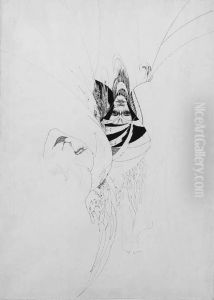Christophe Karel H. De Neree Tot Babberich Paintings
Christophe Karel Henri De Nerée Tot Babberich, more commonly known as Carel de Nerée tot Babberich, was a Dutch artist who lived at the turn of the 20th century. Born on March 18, 1865, in Zevenaar, the Netherlands, he was part of an aristocratic family which influenced his artistic sensibilities and his lifestyle.
De Nerée tot Babberich began his artistic journey at a young age, but his career was overshadowed by his health issues. He suffered from tuberculosis, which greatly affected his life and work. Despite his illness, he managed to produce a significant body of work that included graphic designs, drawings, and paintings. His style was initially influenced by the Symbolist movement, and he was particularly inspired by the works of Aubrey Beardsley, a renowned English illustrator and author.
Throughout his short life, De Nerée tot Babberich's work exhibited a fascination with aesthetics, decadence, and the macabre, which were common themes in Symbolist art. His illustrations often featured elegant, sinuous figures and were characterized by an emphasis on line and form. He also explored themes of beauty and eroticism, which were met with both admiration and controversy during his time.
Although he was relatively unknown outside of the Netherlands during his lifetime, Carel de Nerée tot Babberich's work has gained more recognition posthumously. Scholars have come to appreciate his unique contribution to Dutch art, and his works are now considered important examples of the Symbolist movement in the Netherlands. Tragically, his ongoing battle with tuberculosis ended his life prematurely on October 19, 1909, in Arnhem, at the age of 44.
His legacy is preserved through his contributions to the art world and the influence he had on other artists during the Symbolist movement. De Nerée tot Babberich's works remain a testament to his artistic vision and his commitment to beauty, even in the face of personal adversity.


